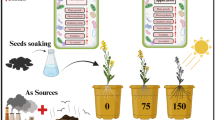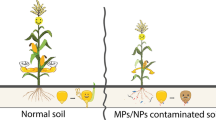Abstract
Peanut sprouts have recently been reported to be rich in some nutrients, including vitamin C, resveratrol, antioxidants, and folate, and are consumed as functional food. However, the effect of indirect plasma treatment, such as plasma-activated water (PAW), on the germination rate and growth of peanut remains largely unknown. Here, we evaluated the effect of PAW produced using a surface dielectric barrier discharge (SDBD) device on germination and vegetative growth in peanut. SDBD-generated PAW had significantly higher nitrate content than tap water (TW). Compared with the TW group, PAW treatment increased the germination rate of peanut seeds by more than twofolds at 3 days after planting; however, there was no significant difference in final germination rate between the PAW and TW groups at 7 days after seeding. In addition, PAW treatment significantly improved biomass-related morphological traits in peanut sprout compared with TW treatment. At the cellular level, PAW treatment increased cell size in the hypocotyl in both the horizontal (115%) and longitudinal (209%) directions, resulting in increased hypocotyl growth. Moreover, histological analysis showed that PAW treatment significantly enlarged parenchyma cell size in hypocotyl pith tissue but did not affect cell number. Overall, these results showed that PAW treatment improved seed germination and growth by enlarging parenchyma and epidermal cell size in hypocotyl, resulting in increased biomass in peanut sprouts. QRT–PCR results showed that auxin response and growth-related genes (AhARF5, AhIAA13, SAUR32, AhGI-13, AhGI-75, AhCUC3-12, and AhCUC3-65) were upregulated in the PAW treated condition at 6 days compared to the TW treated sprouts.





Similar content being viewed by others
References
Abbaszadeh R, Nai PK, Fattahi M, Marzdashti HG (2021) The effects of three plasma-activated water generation systems on lettuce seed germination. Res Agric Eng 67(3):131–137. https://doi.org/10.17221/105/2020-RAE
Adamovich I, Agarwal S, Ahedo E et al (2022) The 2022 plasma roadmap: low temperature plasma science and technology. J Phys Appl Phys 55:373001. https://doi.org/10.1088/1361-6463/ac5e1c
Adhikari B, Adhikari M, Ghimire B et al (2019) Cold atmospheric plasma-activated water irrigation induces defense hormone and gene expression in tomato seedlings. Sci Rep 9:16080. https://doi.org/10.1038/s41598-019-52646-z
Adhikari B, Pangomm K, Veerana M et al (2020) Plant disease control by non-thermal atmospheric-pressure plasma. Front Plant Sci. https://doi.org/10.3389/fpls.2020.00077
Ahmed N, Masood A, Siow KS et al (2022) Effects of oxygen (O2) plasma treatment in promoting the germination and growth of chili. Plasma Chem Plasma Process 42:91–108. https://doi.org/10.1007/s11090-021-10206-2
Ansari A, Parmar K, Shah M (2022) A comprehensive study on decontamination of food-borne microorganisms by cold plasma. Food Chem Mol Sci 4:100098. https://doi.org/10.1016/j.fochms.2022.100098
Attri P, Ishikawa K, Okumura T et al (2020) Plasma agriculture from laboratory to farm: a review. Processes 8:1002. https://doi.org/10.3390/pr8081002
Dawood N (2021) Effects of air plasma treatment on water uptake of wheat and barley seeds. J Taibah Univ Sci 15:1094–1100. https://doi.org/10.1080/16583655.2021.2021014
Dobrin D, Magureanu M, Mandache NB, Ionita MD (2015) The effect of non-thermal plasma treatment on wheat germination and early growth. Innov Food Sci Emerg Technol 29:255–260. https://doi.org/10.1016/j.ifset.2015.02.006
Gao X, Zhang A, Héroux P et al (2019) Effect of dielectric barrier discharge cold plasma on pea seed growth. J Agric Food Chem 67:10813–10822. https://doi.org/10.1021/acs.jafc.9b03099
Ghimire B, Szili EJ, Lamichhane P et al (2019) The role of UV photolysis and molecular transport in the generation of reactive species in a tissue model with a cold atmospheric pressure plasma jet. Appl Phys Lett 114:093701. https://doi.org/10.1063/1.5086522
Han Y, Cheng JH, Sun DW (2019) Activities and conformation changes of food enzymes induced by cold plasma: a review. Crit Rev Food Sci Nutr 59:794–811. https://doi.org/10.1080/10408398.2018.1555131
He Y, Liu Y, Li M et al (2021) The Arabidopsis SMALL AUXIN UP RNA32 protein regulates ABA-mediated responses to drought stress. Front Plant Sci 12:625493. https://doi.org/10.3389/fpls.2021.625493
Hendeniya N, Sandanuwan T, Amarasinghe DAS et al (2021) Atmospheric pressure plasma treatment as a cost-effective and eco-friendly pre-treatment method to enhance seed perfomance in germination and early seedling growth. In: 2021 Moratuwa Engineering Research Conference (MERCon). pp 643–648
Hibara K, Karim MdR, Takada S et al (2006) Arabidopsis CUP-SHAPED COTYLEDON3 regulates postembryonic shoot meristem and organ boundary formation. Plant Cell 18:2946–2957. https://doi.org/10.1105/tpc.106.045716
Jasim SF, Al-zubaidi LA, Abdulbaqi NJ (2021) The effect of cold plasma on gene expression of major genes in the biosynthesis of phenylpropanoids and essential oil contents in Ocimum basilicum L. Ann Romanian Soc Cell Biol 25(4):14996–15010
Ka DH, Priatama RA, Park JY et al (2021) Plasma-activated water modulates root hair cell density via root developmental genes in Arabidopsis thaliana L. Appl Sci 11:2240. https://doi.org/10.3390/app11052240
Krogan NT, Yin X, Ckurshumova W, Berleth T (2014) Distinct subclades of Aux/IAA genes are direct targets of ARF 5/ MP transcriptional regulation. New Phytol 204:474–483. https://doi.org/10.1111/nph.12994
Lee YK, Lim J, Hong EJ, Kim SB (2020) Plasma-activated water regulates root hairs and cotyledon size dependent on cell elongation in Nicotiana tabacum L. Plant Biotechnol Rep 14:663–672. https://doi.org/10.1007/s11816-020-00641-6
Li L, Li J, Shen M et al (2016) Improving seed germination and peanut yields by cold plasma treatment. Plasma Sci Technol 18:1027. https://doi.org/10.1088/1009-0630/18/10/10
Li L, Chen Z, Acheampong A, Huang Q (2022a) Low-temperature plasma promotes growth of Haematococcus pluvialis and accumulation of astaxanthin by regulating histone H3 lysine 4 tri-methylation. Bioresour Technol 343:126095. https://doi.org/10.1016/j.biortech.2021.126095
Li L, Huang G, Xiang W et al (2022b) Integrated transcriptomic and proteomic analyses uncover the regulatory mechanisms of Myricaria laxiflora under flooding stress. Front Plant Sci 13:924490. https://doi.org/10.3389/fpls.2022.924490
Li W, Luna-Flores CH, Anangi R et al (2023) Oxidative stress induced by plasma-activated water stimulates astaxanthin production in Phaffia rhodozyma. Bioresour Technol 369:128370. https://doi.org/10.1016/j.biortech.2022.128370
Limmongkon A, Janhom P, Amthong A et al (2017) Antioxidant activity, total phenolic, and resveratrol content in five cultivars of peanut sprouts. Asian Pac J Trop Biomed 7:332–338. https://doi.org/10.1016/j.apjtb.2017.01.002
Mielecki J, Gawroński P, Karpiński S (2022) Aux/IAA11 is required for UV-AB tolerance and auxin sensing in Arabidopsis thaliana. Int J Mol Sci 23:13386. https://doi.org/10.3390/ijms232113386
Mildaziene V, Sera B (2022) Effects of non-thermal plasma treatment on plant physiological and biochemical processes. Plants 11:1018. https://doi.org/10.3390/plants11081018
Mildaziene V, Pauzaite G, Naucienė Z et al (2018) Pre-sowing seed treatment with cold plasma and electromagnetic field increases secondary metabolite content in purple coneflower (Echinacea purpurea) leaves. Plasma Process Polym 15:1700059. https://doi.org/10.1002/ppap.201700059
Mishra P, Panigrahi KC (2015) GIGANTEA – an emerging story. Front Plant Sci. https://doi.org/10.3389/fpls.2015.00008
Moreno S, Canales J, Hong L et al (2020) Nitrate defines shoot size through compensatory roles for endoreplication and cell division in Arabidopsis thaliana. Curr Biol 30:1988-2000.e3. https://doi.org/10.1016/j.cub.2020.03.036
Nalwa C, Thakur AK, Vikram A et al (2017) Studies on plasma treatment and priming of seeds of bell pepper (Capsicum annuum L.). J Appl Nat Sci 9:1505–1509. https://doi.org/10.31018/jans.v9i3.1392
Pańka D, Jeske M, Łukanowski A et al (2022) Can cold plasma be used for boosting plant growth and plant protection in sustainable plant production? Agronomy 12:841. https://doi.org/10.3390/agronomy12040841
Perea-Brenes A, Gómez-Ramírez A, López-Santos C et al (2022) Comparative analysis of the germination of barley seeds subjected to drying, hydrogen peroxide, or oxidative air plasma treatments. Plasma Process Polym 19:2200035. https://doi.org/10.1002/ppap.202200035
Priatama RA, Pervitasari AN, Park S et al (2022) Current advancements in the molecular mechanism of plasma treatment for seed germination and plant growth. Int J Mol Sci 23:4609. https://doi.org/10.3390/ijms23094609
Puligundla P, Kim J-W, Mok C (2017) Effects of nonthermal plasma treatment on decontamination and sprouting of radish (Raphanus sativus L.) seeds. Food Bioprocess Technol 10:1093–1102. https://doi.org/10.1007/s11947-017-1886-3
Samalova M, Gahurova E, Hejatko J (2022) Expansin-mediated developmental and adaptive responses: a matter of cell wall biomechanics? Quant Plant Biol 3:e11. https://doi.org/10.1017/qpb.2022.6
Stoleru V, Burlica R, Mihalache G et al (2020) Plant growth promotion effect of plasma activated water on Lactuca sativa L. cultivated in two different volumes of substrate. Sci Rep 10:20920. https://doi.org/10.1038/s41598-020-77355-w
Stryczewska HD, Boiko O (2022) Applications of plasma produced with electrical discharges in gases for agriculture and biomedicine. Appl Sci 12:4405. https://doi.org/10.3390/app12094405
Tonks L, Langmuir I (1929) Oscillations in ionized gases. Phys Rev 33:195–210. https://doi.org/10.1103/PhysRev.33.195
Tsukaya H (2019) Has the impact of endoreduplication on cell size been overestimated? New Phytol 223:11–15. https://doi.org/10.1111/nph.15781
Turkan I (2017) Emerging roles for ROS and RNS - versatile molecules in plants. J Exp Bot 68:4413–4416. https://doi.org/10.1093/jxb/erx236
Wang C, Wang N, Li N et al (2021) Combined effects of resveratrol and vitamin E from peanut seeds and sprouts on colorectal cancer cells. Front Pharmacol 12:760919
Wang H, Tang S, Wang J et al (2022) Interaction between reactive oxygen species and hormones during the breaking of embryo dormancy in Sorbus pohuashanensis by exogenous nitric oxide. J for Res 33:435–444. https://doi.org/10.1007/s11676-021-01330-y
Waskow A, Avino F, Howling A, Furno I (2022a) Entering the plasma agriculture field: an attempt to standardize protocols for plasma treatment of seeds. Plasma Process Polym 19:2100152. https://doi.org/10.1002/ppap.202100152
Waskow A, Guihur A, Howling A, Furno I (2022b) RNA sequencing of Arabidopsis thaliana seedlings after non-thermal plasma-seed treatment reveals upregulation in plant stress and defense pathways. Int J Mol Sci. https://doi.org/10.3390/ijms23063070
Weltmann KD, Kindel E, von Woedtke T et al (2010) Atmospheric-pressure plasma sources: prospective tools for plasma medicine. Pure Appl Chem 82:1223–1237. https://doi.org/10.1351/PAC-CON-09-10-35
Zhou Z, Huang Y, He X (2020) Effects of plasma treatment on plant growth and yield of green bean seeds. Int J Res Agric for 7:1–7
Acknowledgements
This research was supported by the "R&D Program of ‘Plasma Advanced Technology for Agriculture and Food (Plasma Farming) No. EN2225-10 through the Korea Institute of Fusion Energy funded by the Korea Government, and National Research Foundation of Korea (NRF) grant funded by the Korea government (MSIT) (No. NRF-2022R1F1A107458511 and NRF-2021R1A2C1005650), Republic of Korea.
Funding
Korea Government, EN2225-10, Young Koung Lee, NRF-2021R1A2C1005650, Young Koung Lee, Korea government, NRF-2022R1F1A107458511, Ilchan Song.
Author information
Authors and Affiliations
Corresponding authors
Additional information
Publisher's Note
Springer Nature remains neutral with regard to jurisdictional claims in published maps and institutional affiliations.
Rights and permissions
Springer Nature or its licensor (e.g. a society or other partner) holds exclusive rights to this article under a publishing agreement with the author(s) or other rightsholder(s); author self-archiving of the accepted manuscript version of this article is solely governed by the terms of such publishing agreement and applicable law.
About this article
Cite this article
Song, I., Jeon, H., Priatama, R.A. et al. Effect of plasma-activated water on peanut seed germination and vegetative growth in a hydroponic system. Plant Biotechnol Rep 17, 573–583 (2023). https://doi.org/10.1007/s11816-023-00847-4
Received:
Revised:
Accepted:
Published:
Issue Date:
DOI: https://doi.org/10.1007/s11816-023-00847-4




